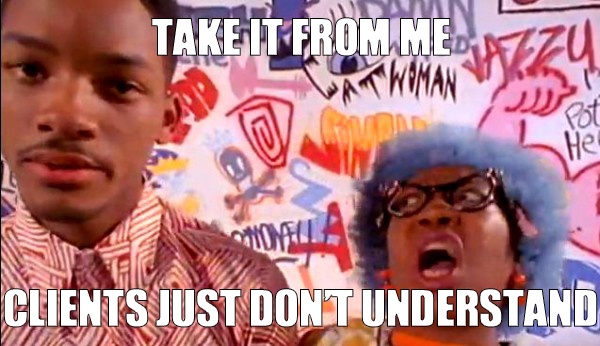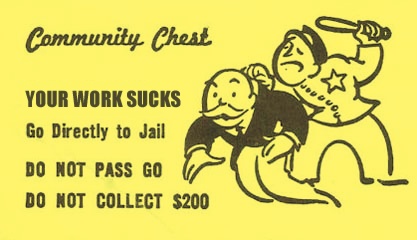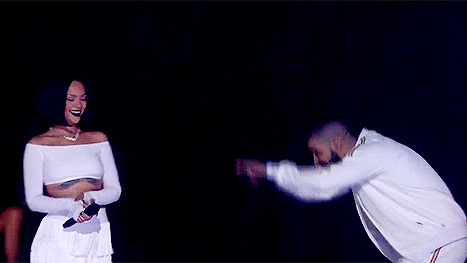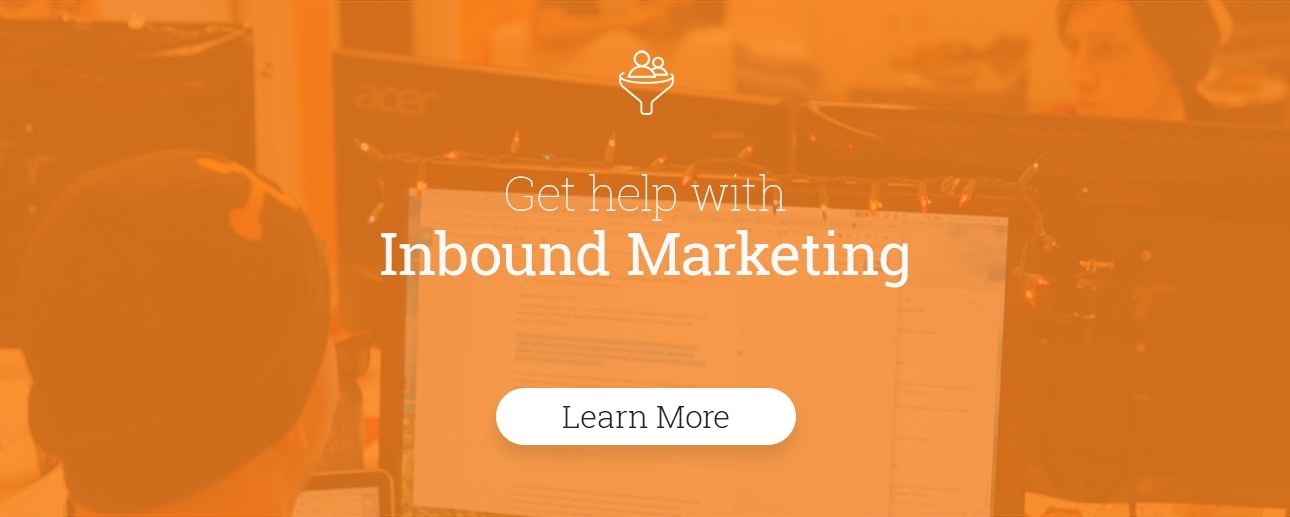Client. The word evokes certain feelings and carries both negative and positive connotations.
On the one hand, the client is the bread and butter of any business-to-business (B2B) organization. They are, in large part, the reason we get up in the morning. The work we’re tasked with doing on a client’s behalf has the power to seriously impact their well-being and long-term success. That’s a lot of responsibility.
Yet, on the other hand some clients just don’t understand. They don’t “get” our work. They can‘t comprehend why we make the decisions we do. And, in some cases, just never seem to be pleased with the results.

Consider Both Sides
As a designer, I see both sides of the coin. I can go from delivering a polished visual identity, designed to establish brand loyalty relationship, to fielding endless rounds of changes on a business card design, all in the span of a week! No two days, thus no two clients, are the same. (I actually have a theory that the smaller the job, the more changes I can expect)
I’m not excusing bad work here. When the results are lackluster, like visibly so, no amount of communication or selling is going to let you pass “Go” to collect your two hundred dollars. If I’m not confident about my work, I’ll typically seek internal feedback before presenting to a client. It saves me from embarrassment and some of the frustration mentioned above. There is no point in defending bad work.

In most cases however, the work is good. I know it is because we’ve done the research and we’ve seen what works. We have both analytical data and anecdotal evidence to support the direction we take on any given project. Clients don’t hire us because we guess. (Although happy little accidents do occur and they are awesome. Especially when they work out in our favor).
So why does it feel like some clients put up a fight? Are they determined to be “right?” Is it their way or the highway? Maybe they lack trust. Or maybe they don’t understand the process. In many of these cases, it’s hardly the client’s fault. I would argue the blame should be placed on the shoulders of the person or agency being contracted to do the work.
Now, some partnerships are just terrible. Doomed from the get-go. For relationships like this, know when to cut your losses and end the relationship. Toxicity in a client-contractor partnership can spread quickly, taking personnel and productivity down with it.
But for the other 90% of clients, they’re typically just as motivated to do good work, too. Still, there is the opportunity for friction. It’s inevitable. The best we can do is work to try and reduce the amount of frustration between client and contractor.
Make Your Client Part of The Process
One of the things that attracted me to Impulse Creative was the small, nimble team and the opportunity to work closely with the individual clients whose long-term success I’d be influencing.. Customer success is part of everything we do here at Impulse Creative. And in the design process, that means gathering the right stakeholders as early on as possible. Lots of the research I do for a design project, whether it’s an e-commerce web design or real estate yard sign, comes during this crucial listening stage.
The discovery meeting we conduct at the outset of any project plays a huge role in laying the groundwork for the rest of the relationship. This is a big part of establishing a sense of trust.
Just because a client has gone through our sales process and signed a contract doesn’t mean they completely trust us.
Building trust comes with time. But with projects that, by nature, need to move quickly because of looming deadlines, the earlier we get face-to-face with a client, the sooner a sense of mutual trust and respect can begin to form.
Everything from phone calls to in-house meetings can help foster trust. But what we really love at Impulse Creative are video calls! Face time is a big part of our success.
Beyond the initial meetings with clients, I like to keep them informed along the way as well. Soliciting feedback often helps keep the project rolling in the right direction. Nothing worse than waiting a week and a half to talk to a client, only to wait another week to get feedback. It stalls momentum and can kill the positive vibes everyone had at the beginning of a project.
What’s more, waiting to reveal an entire concept after weeks of work can often backfire. Instead of acknowledging all the hard work you’ve put into something (which admittedly is what you’re dying to hear) clients will hit you with all sorts of “what ifs” and “how comes.”

By instead creating numerous opportunities where the client can provide their insight and feedback, you make the eventual success of the project a shared experience. If it’s a website project, these opportunities include reviewing sitemaps and wireframes, conducting content interviews, presenting high fidelity prototypes and running a quality control check. Each of these instances makes the client feel involved and allows them a peek into everything it takes to launch a successful website.
With a no surprises approach, we’re able acquire buy-in from the client early and often. This collaboration is crucial to the success of the project and relationship, especially when continuing on a retainer basis. If we’re going to be working with a client for some time, it helps to have open and honest dialogues often. Candor is one of our core values at Impulse Creative and flexing it when needed has been crucial to both maintaining momentum and staying focused toward a client’s goals.
Setting Parameters Just as We Set Goals
Now I don’t want you to think we open the flood gates and let people run wild with feedback and endless rounds of edits. Part of our success as a creative team comes from setting the right expectations.
Developing a set of parameters helps prevent scope creep which is ultimately better for the success of a project. There’s nothing worse than having your creative team being distracted by every random squirrel of a thought. It drains resources and delays launch, causing frustration for all involved parties.
Focus, or the lack thereof, is a key in any project. Without setting parameters, clients don’t know what to expect or how they can be of help and the project lacks focus. We’re firm at the beginning of a project about what you can expect and how you can assist us to deliver the best product possible. We like to involve clients in the process from the very beginning.
Impact With Every Interaction
At Impulse Creative we have a thing we like to say: “Impact With Every Interaction.” Essentially, we like to make sure that every time we sit down with a client, we’re making a significant impact. Otherwise, what’s the point? This impact can show itself in a multitude of ways: sharing an idea, making progress toward a goal or building enthusiasm.
When I work on a design project, I try to create as many points of interaction with the client as possible. By involving them in my process and taking the time to listen to them, I’m ensuring a better product. Something both the agency and I, and most importantly the client, can feel confident about. When the journey is shared, all parties arrive together, on time and ready for the next trip.





